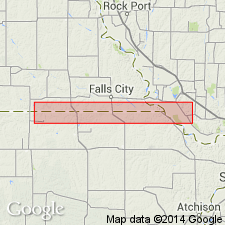
- Usage in publication:
-
- Richardson subgroup [informal]
- Modifications:
-
- Original reference
- Dominant lithology:
-
- Shale
- Limestone
- AAPG geologic province:
-
- Forest City basin
- Nemaha anticline
Summary:
Pg. 4, 5, 9. Richardson subgroup [informal] of Wabaunsee group. Top subgroup of Wabaunsee group. Thickness 80+ feet. Includes Brownville limestone at top and extends down to top of Tarkio limestone (Brownville limestone, 2 to 4 feet; Pony Creek shale, 57 feet; Dover limestone, 1.5 to 4 feet; McKissick [Grove] shale, 10 to 19 feet).
Type locality: the Big Nemaha Valley of southern Richardson Co., southeastern NE, between points south of Humboldt and southwest of Falls City. Named from Richardson Co.
See also "Modern classifications of the Pennsylvanian rocks of eastern Kansas and southeastern Nebraska," compiled by M.G. Wilmarth, Secretary of Committee on Geologic Names, USGS unpub. corr. chart, Oct. 1936, sheet 2.
["Subgroup" not recognized as a formal stratigraphic rank term (CSN, 1933; ACSN, 1961, 1970; NACSN, 1983, 2005, 2021). Considered informal and should not be capitalized.]
Source: US geologic names lexicon (USGS Bull. 896, p. 1808); GNC KS-NE Pennsylvanian Corr. Chart, sheet 2, Oct. 1936.

- Usage in publication:
-
- Richardson subgroup [informal]
- Modifications:
-
- Revised
- AAPG geologic province:
-
- Nemaha anticline
- Forest City basin
- Cherokee basin
Summary:
Pg. 2274 (fig. 1), 2277. Richardson subgroup [informal]. Nemaha-Richardson boundary lowered to base of Tarkio limestone herein reduced to member status in newly proposed Zeandale formation. This change has been agreed to by the Nebraska and Kansas Geological Surveys which are chiefly concerned. As herein redefined, the Richardson subgroup comprises five formations (ascending): Zeandale limestone, Pillsbury shale, Stotler limestone, Root shale, and Wood Siding formation (with Brownville limestone member at top). Age is Late Pennsylvanian (Virgilian).
["Subgroup" not recognized as a formal stratigraphic rank term (CSN, 1933; ACSN, 1961, 1970; NACSN, 1983, 2005, 2021). Considered informal and should not be capitalized.]
Source: US geologic names lexicon (USGS Bull. 1200, p. 3260).
For more information, please contact Nancy Stamm, Geologic Names Committee Secretary.
Asterisk (*) indicates published by U.S. Geological Survey authors.
"No current usage" (†) implies that a name has been abandoned or has fallen into disuse. Former usage and, if known, replacement name given in parentheses ( ).
Slash (/) indicates name conflicts with nomenclatural guidelines (CSN, 1933; ACSN, 1961, 1970; NACSN, 1983, 2005, 2021). May be explained within brackets ([ ]).

